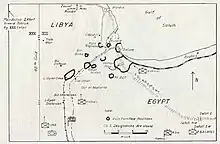
Disposition of British forces during Operation Crusader with the fortifications of Sidi Omar (1941)
Sidi Omar (Arabic: سيدي عمر, romanized: Sayyidī ʿUmar) is an ancient Senussi tomb[1] located in the Egyptian desert in the Matrouh Governorate. It serves as the demarcation of the border between Libya and Egypt since the Italo-Egyptian treaty called the Treaty of Jaghbub (1925)[2]
During the colonial stage of Italian Libya, a series of defensive positions were built on the Italian side of the Frontier Wire (Libya) as support for Fort Capuzzo, also called Sidi Omar (by the British Libyan Sidi Omar) and Sidi Omar Nuovo.[3]
During the Second World War, the area of Sidi Omar played a significant role in Operation Compass, Operation Battleaxe and Operation Crusader[4][5][6]
References
- ↑ "Sidi 'Omar (Sidiomar) Map, Weather and Photos - Egypt: tomb(s) - Lat:31.4 and Long:24.8667". www.getamap.net. Retrieved 2023-04-17.
- ↑ http://library.law.fsu.edu/Digital-Collections/LimitsinSeas/pdf/ibs061.pdf
- ↑ Christie, Howard R. Fallen eagles: the Italian 10th Army in the opening campaign in the western desert, June 1940 - December 1940 (Thesis). Fort Leavenworth, KS: Command and General Staff College (CGSC) MMAS thesis, 04-06-1999.
- ↑ DAVID, BRADDOCK (2019). BRITAIN'S DESERT WAR IN EGYPT AND LIBYA 1940-1942 : the end of the beginning'. [S.l.]: PEN & SWORD MILITARY. ISBN 978-1-5267-5979-5. OCLC 1112418733.
- ↑ Ford, Ken (2010). Operation Crusader 1941 : Rommel in retreat. John White. Oxford: Osprey. ISBN 978-1-84603-500-5. OCLC 436030171.
- ↑ Pitt, Barrie (2001). The crucible of war. London: Cassell. ISBN 0-304-35950-5. OCLC 46498736.
This article is issued from Wikipedia. The text is licensed under Creative Commons - Attribution - Sharealike. Additional terms may apply for the media files.